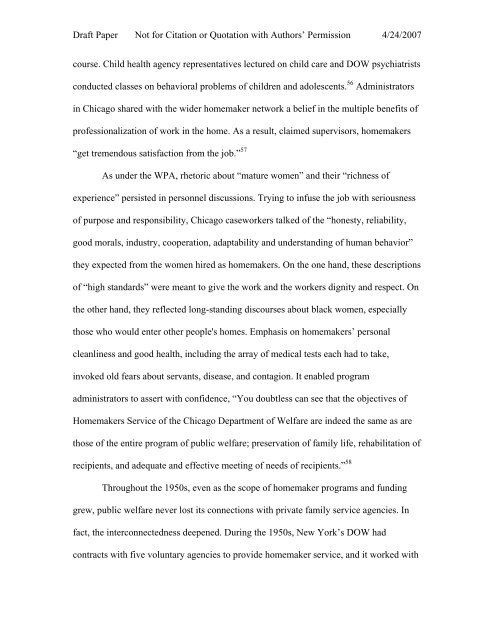Organizing Home Care: - School of Social Service Administration
Organizing Home Care: - School of Social Service Administration
Organizing Home Care: - School of Social Service Administration
Create successful ePaper yourself
Turn your PDF publications into a flip-book with our unique Google optimized e-Paper software.
Draft Paper Not for Citation or Quotation with Authors’ Permission 4/24/2007<br />
course. Child health agency representatives lectured on child care and DOW psychiatrists<br />
conducted classes on behavioral problems <strong>of</strong> children and adolescents. 56 Administrators<br />
in Chicago shared with the wider homemaker network a belief in the multiple benefits <strong>of</strong><br />
pr<strong>of</strong>essionalization <strong>of</strong> work in the home. As a result, claimed supervisors, homemakers<br />
“get tremendous satisfaction from the job.” 57<br />
As under the WPA, rhetoric about “mature women” and their “richness <strong>of</strong><br />
experience” persisted in personnel discussions. Trying to infuse the job with seriousness<br />
<strong>of</strong> purpose and responsibility, Chicago caseworkers talked <strong>of</strong> the “honesty, reliability,<br />
good morals, industry, cooperation, adaptability and understanding <strong>of</strong> human behavior”<br />
they expected from the women hired as homemakers. On the one hand, these descriptions<br />
<strong>of</strong> “high standards” were meant to give the work and the workers dignity and respect. On<br />
the other hand, they reflected long-standing discourses about black women, especially<br />
those who would enter other people's homes. Emphasis on homemakers’ personal<br />
cleanliness and good health, including the array <strong>of</strong> medical tests each had to take,<br />
invoked old fears about servants, disease, and contagion. It enabled program<br />
administrators to assert with confidence, “You doubtless can see that the objectives <strong>of</strong><br />
<strong>Home</strong>makers <strong>Service</strong> <strong>of</strong> the Chicago Department <strong>of</strong> Welfare are indeed the same as are<br />
those <strong>of</strong> the entire program <strong>of</strong> public welfare; preservation <strong>of</strong> family life, rehabilitation <strong>of</strong><br />
recipients, and adequate and effective meeting <strong>of</strong> needs <strong>of</strong> recipients.” 58<br />
Throughout the 1950s, even as the scope <strong>of</strong> homemaker programs and funding<br />
grew, public welfare never lost its connections with private family service agencies. In<br />
fact, the interconnectedness deepened. During the 1950s, New York’s DOW had<br />
contracts with five voluntary agencies to provide homemaker service, and it worked with
















